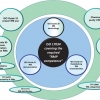In the Quality Matters Column, Peter Jenks, Paul Boother and Annette Marshall are concerned about “The proper use of certified reference materials for analytical instrumentation qualification”. There are many aspects to consider in ensuring the validity of an analytical system, from before any instrumentation is installed, before it is used and during its use. Readers interested in the chemicals and reference material field may be interested in the news that, as this issue was being prepared, Merck completed its $17-billion acquisition of Sigma-Aldrich.
Quality Matters Columns
Editors: Chris Burgess, John Hammond and Peter Jenks
The Quality Matters column is dedicated to issues around reference materials and standards, including the underlying regulations that are of great importance to the majority of laboratories. Read more about the Column Editors.
Pages
In the “The analysis of poly aromatic compounds: a never-ending story?”, Peter Jenks reports from the 25th International Symposium on Poly Aromatic Compounds. He concludes that “data from the academic and research community often acts as a stimulus for government concern and the data may ultimately result in legislation. It concerns me that legislation may be driven by bad data”.
John Hammond updates us on “Reference materials: what’s new?”. The 2015 meeting of the ISO Committee on Reference Materials (ISO/REMCO) was held in June and significant developments in a number of standards that will ultimately affect all users of reference materials have taken place.
In the Quality Matters Column, Peter Jenks reminds us about “BERM 14: it’s that time again!”. The latest in this line of conferences on Biological and Environmental Reference Materials is being held in the USA in October 2015.
C. Burgess and J.P. Hammond outline the work that has been undertaken to modernise the spectroscopic General Chapters in the United States Pharmacopeia (USP).
Peter Jenks seeks to show where it is important to check the CRM or RM you are using includes a clear statement of commutability, and when and where it can be largely ignored.
In the Quality Matters column, Peter Jenks and John Hammond look “Into the future: changes to ISO 17025 and ISO Guide 34”. There is a lot happening at present around ISO/IEC 17025 and ISO Guide 34, which together provide the framework for the development and use of certified reference materials in analytical laboratories around the world. John reports from the recent 37th meeting of the Reference Material Committee of ISO (ISO/REMCO) and provides an update on the topic of “commutability”.
Peter Jenks is off to a conference. He describes the history of the Biological and Environmental Reference Materials (BERM) series of conferences and concludes that they still are important for all of us 30 years after their start. He urges you to attend the next, in October 2015 in the USA.
John Hammond and Chris Burgess are also in the middle of a multi-part contribution to the Quality Matters column. “…that’s what I thought you said?” looks at further misundertandings in terminologies surrounding Reference Materials, and sets the record straight.
Peter Jenks clarifies “What is a ‘Primary Standard’?”.
John Hammond reports on important developments at the ISO Committee on Reference Materials (ISO/REMCO) annual meeting.
Peter Jenks and John Hammond describe how the important ISO 17025 standard has developed, and point out that a review for the third edition of the standard will start soon. All those with an interest in quality standads—an increasing number of us—should make sure their voice is heard at their local standards body.
Peter Jenks argues that the two quality approaches, ISO 17025 and cGMP, are both lacking, but both could be made much better and virtually identical with single but different improvements!
Peter Jenks has discovered quantitative NMR. in his article titled “NMR: is it the future for the analysis of organic molecules?”. If only it wasn’t so expensive, it might be the perfect method to certify pure organic compounds.
Peter Jenks and John Hammond continue their series on “CRMs and PT in an ISO 17025 accredited laboratory” with instructions on how you can prepare your own in-house certified reference materials.
Peter Jenks looks at some current trends in the supply of CRMs and proficiency testing and highlights difficulties labs may have been when no commercial CRM is available. This will be followed with a second part looking at the production of in-house reference materials.
Peter Jenks gains new respect for microbiologists and learns that the way they approach analytical quality control is different from chemists.
Chris Burgess and John Hammond respond to Peter Jenks' thoughts in the last issue's Quality Matters Column. Please join in the debate and add your comments at the end of the article.
The reasoning behind strict compliance to an ISO Standard is logical, but the consequences can be commercially questionable, if not unsound. Peter Jenks, and many other scientists, are starting to question the commercial viability of all this regulation. What is your opinion?
Peter Jenks is concerned at the lack of mutual help available on the Internet within the field of analytical chemistry. Other fields, outside science, have strong communities where enthusiasts give freely of their advice and time; why not in analytical chemistry? Please tell us your views by adding a comment to this column article.


